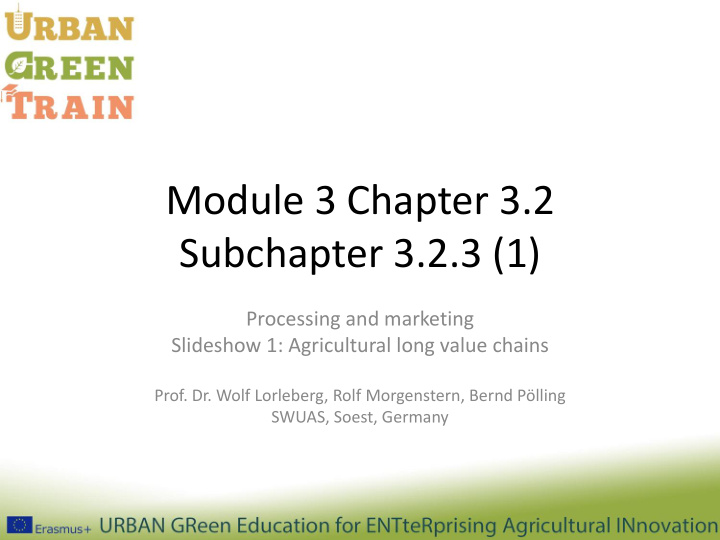



Module 3 Chapter 3.2 Subchapter 3.2.3 (1) Processing and marketing Slideshow 1: Agricultural long value chains Prof. Dr. Wolf Lorleberg, Rolf Morgenstern, Bernd Pölling SWUAS, Soest, Germany
Overview Examples of common value chain: • Horticultural value chain • Pork meat value chain • Milk and dairy value chain Marketing complexity Typical rural farming marketing • Value chains: horizontal / vertical • Producers‘ associations • Auctions and exchanges
The horticultural value chain …a first exemplary and simplified impression of the horticultural value chain, here for fresh products. Figure (adjusted) from Klett-Verlag, Lehrmaterialien
The pork meat value chain ....with its different specialized members. mineral feeding stuff import nutrients fertilizer maize and (cereals, soya) for crops cereals slaughter- (own farm or butcher bought in) house breeding farm fattening farm 220 days gestation in 10-12 groups 16 weeks manure (slatted floor) breeding sow slaughter 8-10 piglets (artificial weight (3 weeks insemination) 95 kg with sow) piglets (25 kg) fattened pig (220 kg) Figure (adjusted) from Klett-Verlag, Lehrmaterialien
The milk and dairy value chain supply production transport direct marketing Figure (adjusted) from processing sale Klett-Verlag, Lehrmaterialien
Marketing complexity Visualization of the marekting complexity for a basic product like wheat – an exemplary material flow chart for German wheat market some years ago (language is German, but the intention is to show the complexity only)
How do typical rural farms market their products? • Typically, farms market their products not directly to the consumers, but to the food processing industry or trading enterprises. • Often farm production is bundled by specialized private or cooperative trading enterprises, or other forms of producers ‘ associations for joint marketing. Without bundling farm production logistic and transaction costs would be too high, and the competitivity position of farmers against food processors and supermarkets would be too weak – and they would not be able to meet quantity and quality requirements of the modern marketing chain...
Producers‘ associations (joint marketing associations) in the pork meat value chain: To bundle farm production by producer owned (and controlled) enterprises is typical for Slaughtering / Processing - pork meat, - arable crops, - fruit and vegetable production (Marketing) Producers‘ Associations This is also called „ horizontal integration “. Fattening F F F F F F farms There are also commercial cooperations along the value chain, mostly in the framework of so called contract production. Piglets Contracts – often together with input supply, advisory and a guarantee for marketing are offered by food processors and sometimes by supermarket chains; it is typically strong f. e. in Breeding chicken, potato and vegetable products industries. (Contract) cooperation between partners: This model is also called „ vertical integration “. Farms have the - Farmers / organizations advantage of a sales and income guaranty, but give up their - Slaughterhouses entrepreneurial independence.... - Processing companies Figure (adjusted) from Moser & Funk, 2003: 181
Auctions and exchanges – two modern instruments of agricultural marketing Especially for horticultural products (but existing also for slaughter animals), marketing via auctions is an opportunity to distribute high quantities with modern logistics. Further, commodity futures exchanges have two functions related to agricultural product marketing, Photo: deutsche-boerse.com but there are traded only „ products on paper “ (= derivates), not physical products: - Price formation by future contracts are supporting/trend setting – often determining (!) market price formation on physical markets and - Producers, processors and traders can cover their price risks making use of future contracts; this is called „ hedging “ . Photo: wz.de
Recommend
More recommend